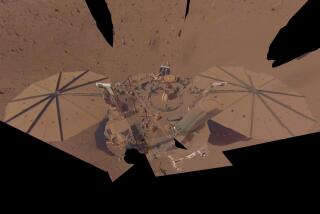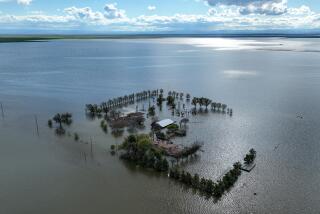Mars had a long-lasting series of lakes, NASA’s Curiosity rover finds
The dry, dusty crater that NASA’s Mars rover Curiosity is exploring was once filled with a series of lakes that together may have lasted for millions of years, scientists at Jet Propulsion Laboratory say.
The findings, published by the journal Science, show that liquid water may have existed for long enough on the planet for life to (hypothetically) begin and thrive.
“We as a science community have to come to grips with the fact that, sometime between 3.2 and 3.8 billion years ago, water was really stable on the surface of Mars,” said lead author John Grotzinger, a Caltech geologist and Curiosity’s former project scientist.
Since landing in Gale Crater in 2012, snapping pictures and drilling rocks, Curiosity has found plenty of evidence that liquid water was present in the rust-hued planet’s distant past. In Yellowknife Bay, the rover even discovered clear signs of a past habitable environment, filled with life-friendly chemicals.
“The geology of Mars still holds the tantalizing possibility that extraterrestrial life might exist or have been preserved, because the evidence of water is so plentiful,” Marjorie Chan of the University of Utah, who was not involved in the paper, wrote in a commentary.
But how long did this wet, life-friendly environment stick around? It would have to last long enough for life to emerge. Scientists don’t know how long that might take, but it could be on the order of millions of years. A lake that lasted a mere millennium simply wouldn’t cut it.
The newly published research takes into account observations from across Curiosity’s journey, from its landing site all the way to the base of Mt. Sharp, the 3-mile-high mountain in the middle of Gale Crater.
Over about 9 kilometers and about 75 meters of elevation, the rover examined dozens of outcrops, the study authors wrote. They looked at the size and patterns of grain in the rock and found signs of sediments deposited by streams. Closer to the middle of the crater, they found even smaller sand-sized grains – the kind you would see in delta deposits, where the streams should meet a lake. They found evidence for just such a lake, with even finer mud-sized grains.
Gale Crater, the scientists say, probably held a series of lakes over time that rose and fell before and filled again, connected through a shared groundwater table.
“This intracrater lake system probably existed intermittently for thousands to millions of years, implying a relatively wet climate that supplied moisture to the crater rim and transported sediment via streams into the lake basin,” the study authors wrote.
Scientists have recently found evidence for extremely briny water flowing on present-day Mars, but pure liquid water couldn’t really survive on the planet today; the atmosphere is so thin that the water would either boil off or freeze solid, depending on the temperature.
So if there is evidence for long-lived bodies of standing water, that means the atmosphere must have been much thicker, perhaps filled with puffy clouds, able to support a water cycle that might have included precipitation (rain or snow). This world would have looked, in short, a lot more like our own planet.
“The more the geology looks like Earth, the more likely it seems that some life-form(s) could have developed in the martian waters,” Chan wrote.
Can’t get enough of the Red Planet? Follow @aminawrite for more interplanetary science news.







